
The young Cuban widow, Doña Petrona de Castro, suffered in the shadows during the first half of this story, but moved to center stage after the bloodied vessel Nuestra Señora docked in Charleston. When her disheveled treasure came ashore in late June 1734, the pregnant lady’s plight attracted the personal attention of South Carolina’s respected royal governor. Under his personal supervision, members of the provincial government secured the señora’s private property and initiated steps designed to render solace to their distressed Hispanic guest.
The wandering Cuban schooner arrived in Charleston Harbor on Wednesday, June 26th, carrying eight survivors of a murderous mutiny and counter-mutiny that claimed eight lives. Early the next morning, the motley group of English, Cuban, French, Maltese, and African visitors received a call from two Spanish-speaking persons then residing in Charleston—Irish merchant William Kellaway and Florida mariner Don Domingo de la Cruz (or Crux). In their presence, the young, widowed owner of the schooner, Señora de Castro, packed her belongings and locked her private cache of Spanish pieces-of-eight into three trunks, which Captain William Vaughn later carried on shore.
The two Spanish-speaking gentlemen probably helped the survivors secure lodgings in Charleston. The location and nature of their various accommodations is not known, but one clue might point to the temporary residence of Doña Petrona. Later records indicate that she paid a sizeable sum of Spanish pieces-of-eight to a Charlestonian named Jane Grassett, who likely served as the Cuban widow’s landlady or host. Madame Grassett, about whom little is known, was a relatively young woman of French Huguenot extraction who had several small children of her own with a husband named Samuel. In 1734, Jane Grassett was likely the maternal aunt of a ten-year-old boy named Henry Laurens, who later became a famous Charlestonian.[1]
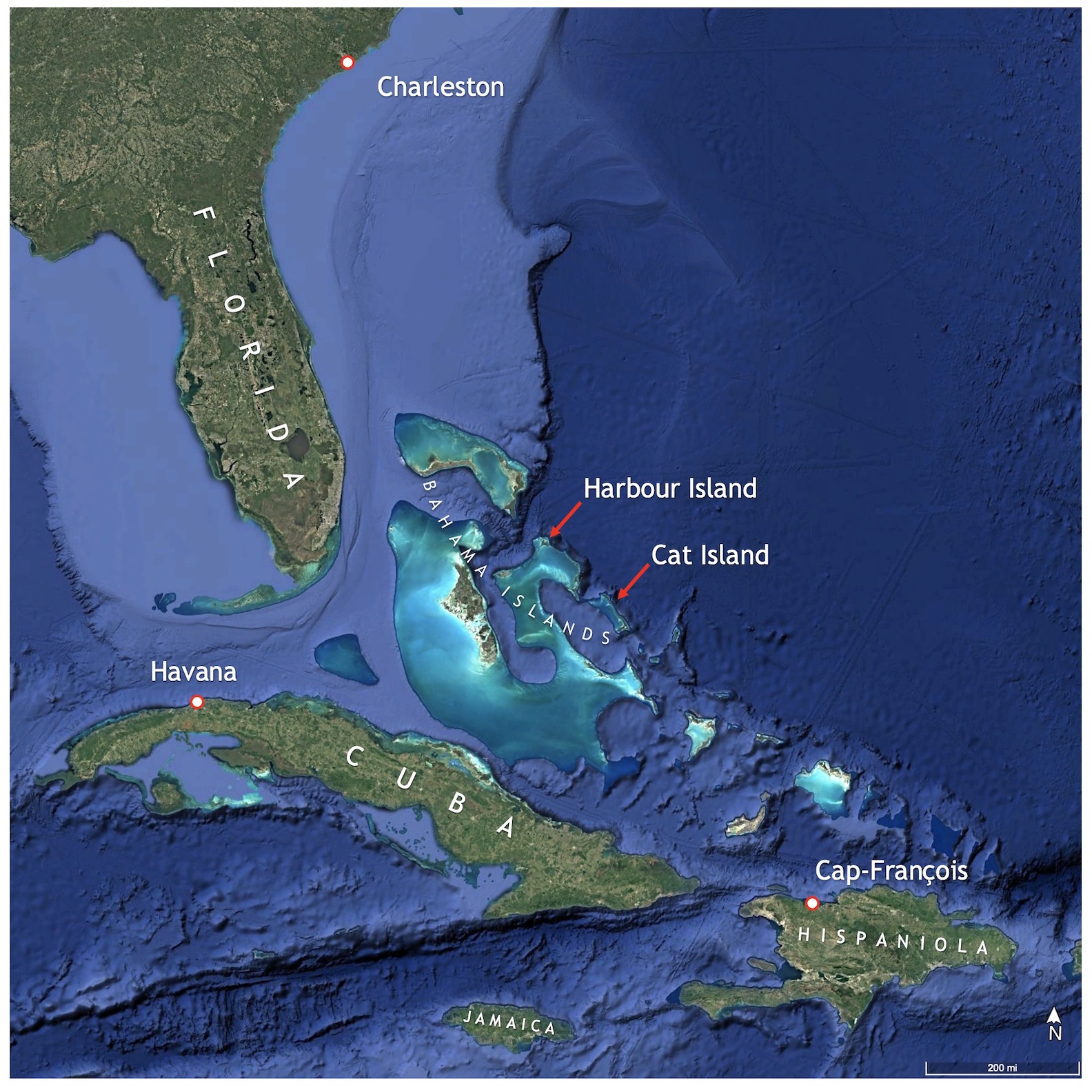
Word of their terrifying journey from Havana to Charleston reached the ears of fifty-eight-year-old, widowed Governor Robert Johnson by Thursday morning, when he ordered a guard to keep watch aboard the Nuestra Señora. He also dispatched agents to compel the survivors to visit an unspecified office of the provincial government. There South Carolina’s Attorney General, James Abercromby, and Secretary of the Province, John Hammerton, recorded depositions from Señora de Castro, Captain William Vaughan, cook Joseph Ratto, carpenter Joseph Lortia, and seamen Joseph Diancona and Pierre Blanchard—but not the schooner’s French passenger or the young widow’s enslaved servant. Because the majority of these subjects were not fluent in English, William Kellaway and Don Domingo de la Cruz probably assisted with these initial interviews. Also in attendance was Lewis Timothy, the young Huguenot printer of the South Carolina Gazette, who took copious notes for his weekly newspaper. In the summary he published two days later, Timothy reported that the successive depositions lasted “from eleven in the morning till past 5 in the afternoon.”[2]
On the morning of Friday, June 28th, Governor Robert Johnson met with several members of his advisory council, known as His Majesty’s Council for South Carolina, including John Fenwick, Joseph Wragg, John Hammerton, William Bull, and their recording clerk, Jesse Badenhop. The provincial General Assembly was not in session at that time, but the governor often met with members of Council to address various non-legislative matters. Their customary meeting place in 1734 was a venue known as the Council Chamber, a commodious, well-appointed state room at the east end of Broad Street. Standing one flight of stairs above the town’s masonry Watch House, rebuilt in 1725–28, the executive chamber overlooked the waterfront Half-Moon Battery and commanded a panoramic view of Charleston Harbor.[3]
The governor and councilors spent the morning studying each of the six depositions gathered the previous day. Part of their interest likely stemmed from a sort of morbid curiosity, though there were much larger issues at stake. Great Britain and its American colonies were technically at peace with Spain at this time, but a growing chorus of bilateral complaints about trade abuses in the Caribbean basin was gradually pushing the two nations towards open warfare. Furthermore, the creation of the new colony of Georgia in 1732 had reignited a long-simmering dispute about the boundary between British Carolina and Spanish Florida. While diplomats negotiated those incendiary topics in Europe, Governor Johnson in South Carolina signed an unofficial peace treaty with the Spanish Governor of Florida in November 1733.[4] That long-forgotten agreement fostered a brief period of relatively relaxed traffic between Charleston and St. Augustine that encouraged bilingual merchants like William Kellaway, Don Domingo de la Cruz, and others to shuttle between the two colonies with unprecedented ease.
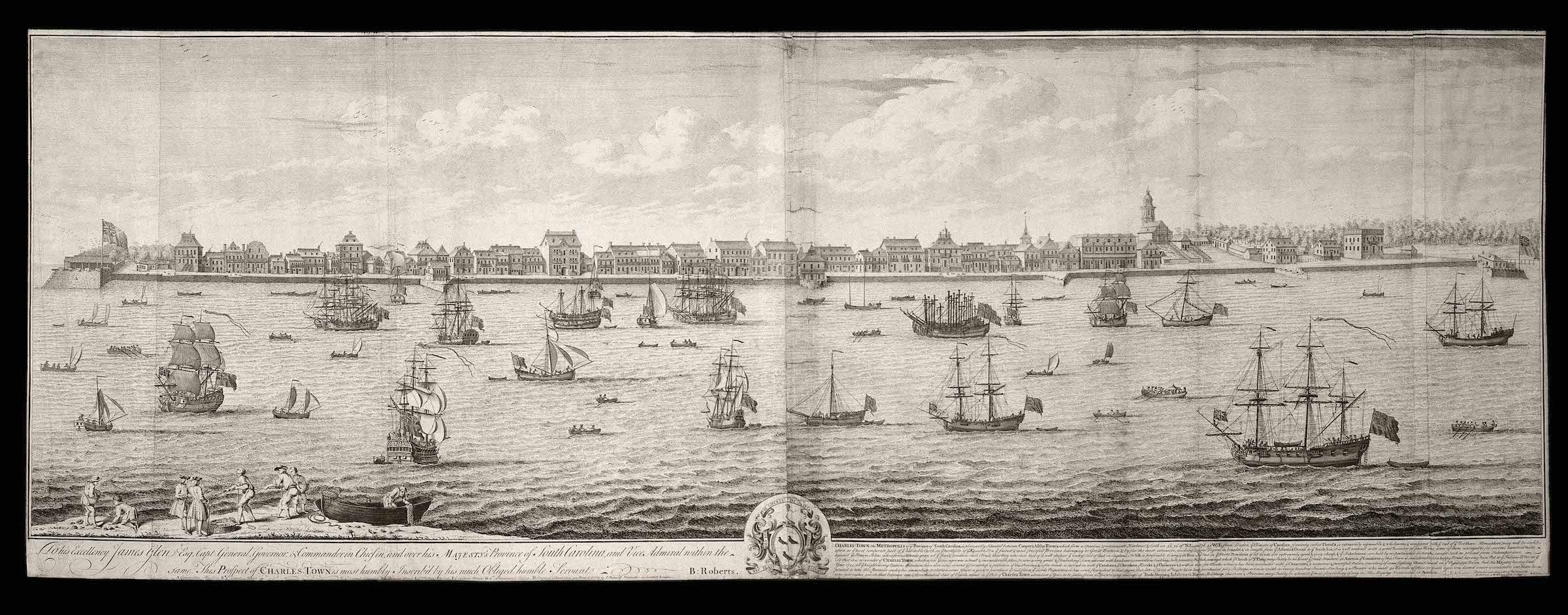
In this context of tenuous peace between Britain and Spain in the summer of 1734, the arrival of the Nuestra Señora stirred a sense of civic duty in the minds of Governor Johnson and his peers. To demonstrate to Crown officials in London both a strict adherence to the letter of British maritime law and the fair treatment of foreign visitors in South Carolina, Governor Johnson pursued a rather formal course of action that engendered a written record of their proceedings. To these political motivations we might add a bit of paternalistic chivalry. The owner of the visiting Cuban schooner was—to borrow a phrase from romantic literature—a “damsel in distress.” More precisely, she was a “lady,” an affluent woman whose social status, in class-conscious minds of the eighteenth century, entitled her to more respect and courtesy than a “common” woman, regardless of her age, language, or religion. Conceiving of themselves as proper British gentlemen, the widowed governor and his peers treated the young Señora de Castro with the same delicacy and respect they would expect for their own wives and daughters.
After reading the depositions concerning the chaotic voyage of Nuestra Señora, which the English colonists identified as “the Mary,” Governor Johnson summoned the Provost Marshal of South Carolina, Englishman Robert Hall, and ordered him to bring the Bahamian captain William Vaughan into the Council Chamber for further interrogation. Vaughan’s second sworn statement before the governor does not survive, but it evidently focused on the quantity of money he had transported from the Cuban schooner to town the previous day. The several depositions indicated that the Canary pirates had stolen the owner’s private fortune, then shared the money with several crewmen, and then repossessed all the booty and hoarded it to themselves. That chaotic chain of possession, which had jumbled all the money onboard the vessel, compelled Governor Johnson to verify as transparently as possible that Señora de Castro received full restitution of her husband’s fortune.
After interrogating Captain Vaughan about his role in removing Doña Petrona’s valuables from the schooner the previous day, Governor Johnson ordered Provost Marshal Hall to visit the señora and invite her to the Council Chamber after their midday meal. Mr. Hall was also required to bring into the Council Chamber all the chests containing her silver. Before adjourning for dinner, Johnson charged the marshal to ensure that the chests remained within Doña Petrona’s sight during the entire journey from her lodgings to the executive chamber.[5]
Later in the afternoon of the 28th, Marshal Hall escorted the heavily-pregnant Doña Petrona de Castro into the Council Chamber with porters carrying three locked wooden chests. They were accompanied by William Vaughan and a pair of lawyers, Maurice Lewis and Rowland Vaughan (probably a relative), hired by the captain to represent himself and Señora de Castro. To translate their conversation with the Spanish lady, the governor had summoned an enigmatic figure known in Charleston as Peter Francis Neri, but who was better known in St. Augustine as Pedro Francisco Neri. With his linguistic assistance, Johnson politely informed the señora that he had read the several depositions taken the previous day, “was sorry to hear of her misfortunes,” and pledged to “serve her in all he could.” He had already sent two men to keep watch aboard her schooner in rotation with one appointed by Doña Petrona, “to take care that nothing should be embezel’d.” The young widow, no doubt distressed by the traumatic sea voyage, responded that “she knew nothing of the chests being sent for on shore, and [was] oblig’d to his Excellency [the governor] for his care.” Johnson added that he “had sent for scales and weights to weigh the silver” in her possession, “to know how much there was of it” and confirm the identity of its rightful owner(s).
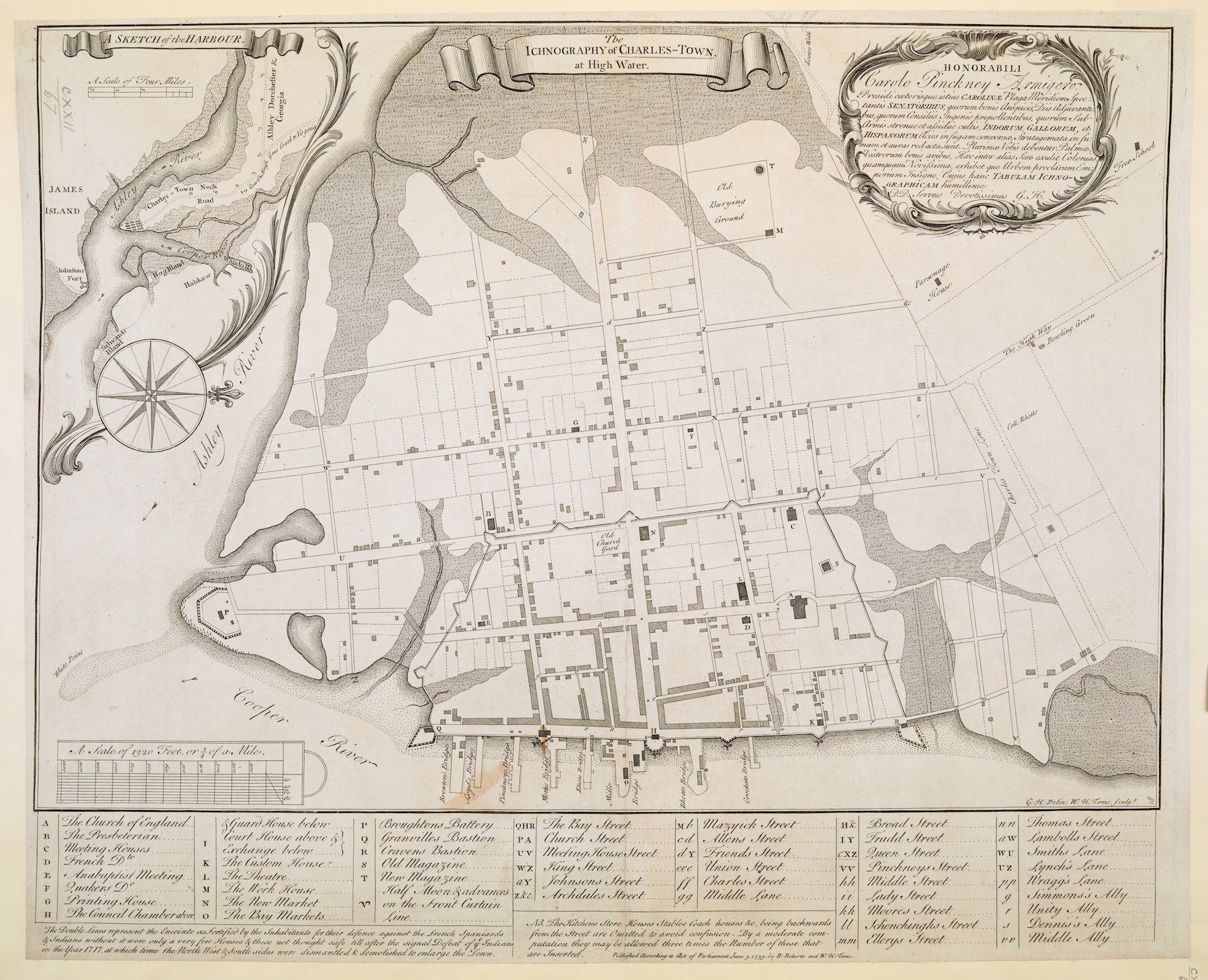
William Kellaway and Don Domingo de la Cruz arrived at this point, summoned by the governor to confirm that the wooden chests about to be opened in the Council Chamber contained the same quantity of bags as they saw the previous day, before Captain Vaughn carried them ashore. Doña Petrona still held the keys and confirmed that the locked chests had not been opened since they were delivered to her new apartment. She could not answer questions about the total quantity of coins in her possession, however, and apologized “that her troubles made her forget her self.” “As near as she could guess,” the señora believed that her husband, Don Francisco de Heymes, had carried “between 5 or 6000” pieces of eight on board Nuestra Señora before they departed from Havana. That figure surprised Governor Johnson, who observed that the lady’s deposition taken the previous day indicated that she had “but one hundred pistoles and four hundred p[iece]s of eight.” The lesser amount was only the money in her private custody, Señora de Castro explained, asserting “that she really believes her husband had in the whole way of trade between five and six thousand,” while the rest was “her own property.” She possessed no documentation of her husband’s assets, including title to their private schooner, because “the murderers throw’d them all over board in a trunk,” along with “a suit of her husband’s cloaths.”
Turning to a graver matter, Governor Johnson then asked the Cuban widow “whether she apprehends the carpenter [Joseph Lortia] was joyn’d in confederacy with the murderers.” Doña Petrona shook her head and replied that “she was confin’d 30 days in her bed, and knows nothing of his behaviour.” Lortia had visited her cabin from time to time during the voyage, however, and always “spoke to her in a seeming supliant manner.” Johnson, politely probing for details of her husband’s death, asked the lady “whether she remembers anything of it.” “No,” she responded, unwilling to recall that horrible night, and the governor quickly changed the subject. How did she regain custody of the keys to her wooden chests? he asked. The murderers, having ransacked her cabin and discovered the keys, unlocked the chests, removed all the valuables, and cast aside her “linnen and cloaths.” Pierre Blanchard and the others returned the keys to her after they killed the last of the pirates, and she had maintained custody of them since that time. Johnson then quizzed the señora about the payment of 200 pieces of eight to Captain Vaughan after the death of the last pirates, but she could not recall the details of the transaction. She knew that the captain was paid, but wasn’t sure if the money had come from one of her chests. She apologized to the English governor, explaining “that since her husband’s murder, she has been so troubled that she cannot remember many particulars.”
The governor then turned to Pierre Blanchard, who had evidently been summoned to the Council Chamber for a second deposition under oath. The Frenchman acknowledged that the pirates had ordered him to promise 400 pieces of eight to Captain Vaughan if he would pilot the schooner back to Havana—200 in advance and 200 more when they reached Cuba. That bargain was made in the presence of Doña Petrona, said Pierre, and the lady had also “promised him [that is, Captain Vaughan] the schooner when they came to the Havana.” Johnson could not resist the opportunity to ask Blanchard an obvious question—“how he came not to discover to Vaughan, before the schooner came to Florida, that the mullato’s had kill’d the lady’s husband and the other three?” Pierre explained briefly that “they were afraid the murderers would take umbrage at it, and [he] took the first safe opportunity of telling Vaughan of it.”
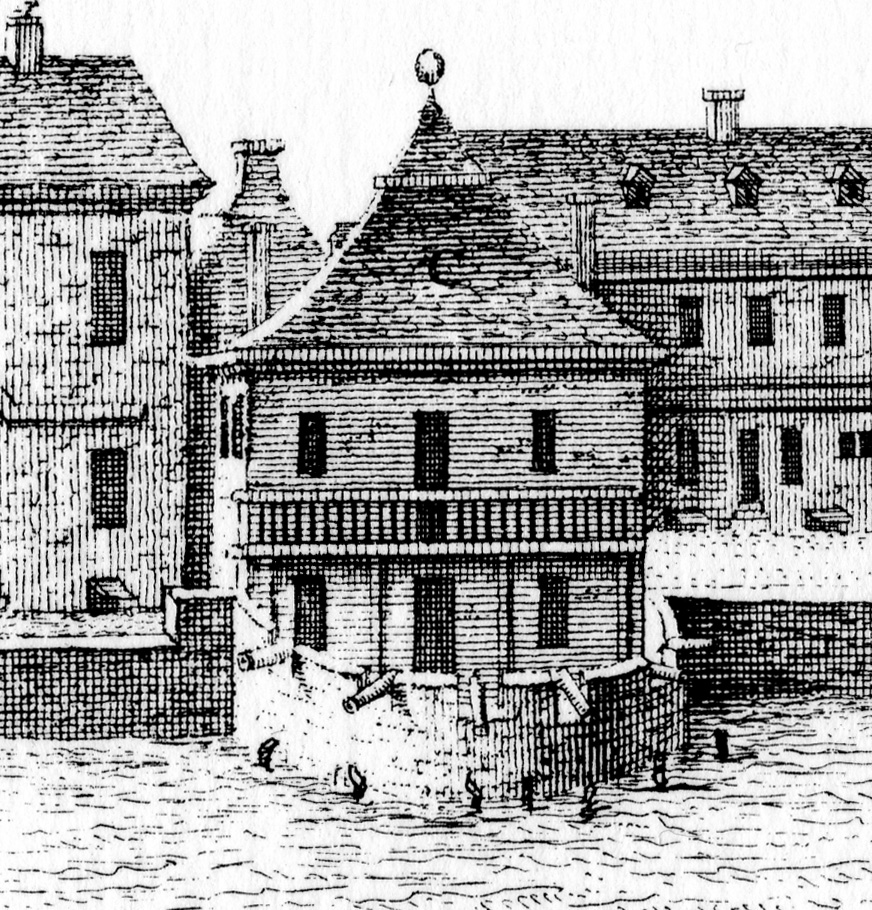
Returning to monetary matters, the governor quizzed the Frenchman about the assets of several crewmen aboard the Cuban schooner. Blanchard said he believed the cook, Joseph Ratto, had some quantity of silver coins, but he was sure the carpenter, Lortia, had no money. What made him so sure? Johnson asked. Before their departure from Havana, said Pierre, a merchant had visited the schooner to collect a small debt from Lortia, but the carpenter had nothing to give the man. Furthermore, the Frenchman volunteered, “he believes the carpenter was concern’d with the murderers, he [Lortia] having run after [Blanchard] with a knife in his hand” on one occasion. Later, when one of the pirates “ran after him [Pierre] with a hand spike,” Lortia had cried out “don’t kill him yett, for we shall want him by and by to hoist out the boat.”
The Frenchman’s frank assessment of Lortia’s culpability likely raised a few eyebrows in the Council Chamber, but the governor steered the conversation back to matters of property. Johnson showed to Doña Petrona “a deed of gift of the schooner with her name on it,” transferring ownership of Nuestra Señora to William Vaughan free of charge. He asked if she had understood the contents of the deed before she signed it earlier that day. The document was not translated for her, she replied, but Pierre Blanchard had provided her with a verbal summary of its contents. The señora said she had agreed to convey title of the schooner to Captain Vaughan on the condition that he “was to sett her down safe at the Havanna, either in the schooner, or a small sloop, at his own cost and charge.” The governor politely explained that “there was no such condition in the said deed,” and asked Mr. Neri “to read the same to her verbatim [in Spanish], that she might know the contents.” Doña Petrona listened to Neri’s recitation and expressed surprise at the omission of the conditional clause, which Pierre had told her was present in the document.
The two lawyers who had prepared the deed of gift, Maurice Lewis and Rowland Vaughan, then stepped forward from the periphery of the spacious chamber. They confirmed that the document in question “was a free deed, without any consideration whatsoever,” and Mr. Lewis asserted under oath that he had truthfully represented its contents to Pierre Blanchard during a conversation that morning in the presence of Señora de Castro. Governor Johnson turned to the Frenchman and asked why he had misled the widow the about the nature of the document before she signed it. “To tell the truth,” Pierre confessed with a shrug, “he did not understand one half [of what] was said to him” in English.
Speaking in defense of the Frenchman, Captain Vaughan acknowledged that he had heard Pierre mention the condition requiring him to convey Señora de Castro back to Havana, and he had communicated the lady’s expectation to the attorneys, but that conversation occurred after she signed the deed of gift. Governor Johnson, now clearly frustrated by the convoluted disposal of the schooner, informed Doña Petrona that the lawyers Vaughan and Lewis had identified themselves earlier as her representatives. Captain Vaughan interjected that he was responsible for hiring the two lawyers and had merely offered their services as a complement to the lady. Johnson turned his gaze back to the young, disconsolate widow, who sighed that “she was but a woman, and did not understand these affairs.” “The deed was an unfair one,” Johnson surmised, and asked Captain Vaughan if he would consent to its nullification. With the mariner’s assent, the flawed deed of gift “was cancelled in the presence of Council” and “delivered to the lady.”

The governor then asked Mr. Neri, the translator, “to acquaint the lady, that it [was] incumbent on the gover[nor,] as chief magistrate [of the colony], to take care of the effects [i.e., the chests of silver] now in presence of the Council.” Before taking possession of her treasure, said Johnson, “he design’d to take an inventory of all contained in the chests, and then to have them sealed up, with the governor’s and lady’s seals.” Doña Petrona signaled her consent and handed keys to the obliging governor, whose agents then opened the chests and began counting and weighing every coin in full view of the elite audience. The lady’s jewelry and other valuables evidently remained locked within other chests that were still aboard the guarded schooner in Charleston Harbor.
After the tedious exercise of inspecting, weighing, and recording every Spanish coin collected from Nuestra Señora, Mr. Badenhop, the Clerk of Council, recorded a total of 2,669 ½ pieces of eight containing 2,136.75 ounces of silver. Colonial officials then returned the numerous coins to their original canvas bags, each of which was tied and sealed with crimson wax. Governor Johnson and Señora de Castro then used their respective signet rings to make distinctive impressions in the hot wax to discourage theft. The nine bags were then repacked into three chests, which were locked before numerous witnesses, and the keys delivered back into the hands of Doña Petrona. To render the greatest security possible to the señora’s private property, Johnson ordered porters to carry the chests to his own residence on East Bay Street and place them in “the governor’s bed chamber.”[6] In short, Robert Johnson orchestrated a well-attended act of colonial political theater to render a modicum of comfort to the weary, young, pregnant Cuban widow.
In the Council Chamber on the morning of Saturday, June 29th, Governor Johnson met with the same members of council to review a transcript of yesterday’s proceedings. Attorney General Abercromby attended and, after a bit of banter, moved that “a special court may be called . . . for the tryal of Joseph Delorti [i.e., Lortia], carpenter of the schooner.” The lawyer’s pronouncement likely sharpened the governor’s attention. With what specific crime might the king’s attorney in South Carolina charge the Hispanic visitor? he likely asked. If Lortia had joined in confederacy with the pirates at any point during the recent voyage, he was, in the eyes of British law, an accessory to murder and robbery at sea, charges answerable to a statute from the reign of William III concerning piracy and all other felonies committed on the high seas.
The governor and the elite members of His Majesty’s Council all signaled their consent to Abercromby’s recommendation. At his executive desk within their presence, Johnson signed a warrant drawn by the attorney general directing Provost Marshal Robert Hall to arrest Joseph Loria and confine him within the provincial jail until further notice. The governor also signed a warrant directing the marshal and his deputies to search the Cuban schooner, the lodgings of William Vaughan, and “any other house he may suspect[,] for Spanish coin brought on shore from on board” the vessel.
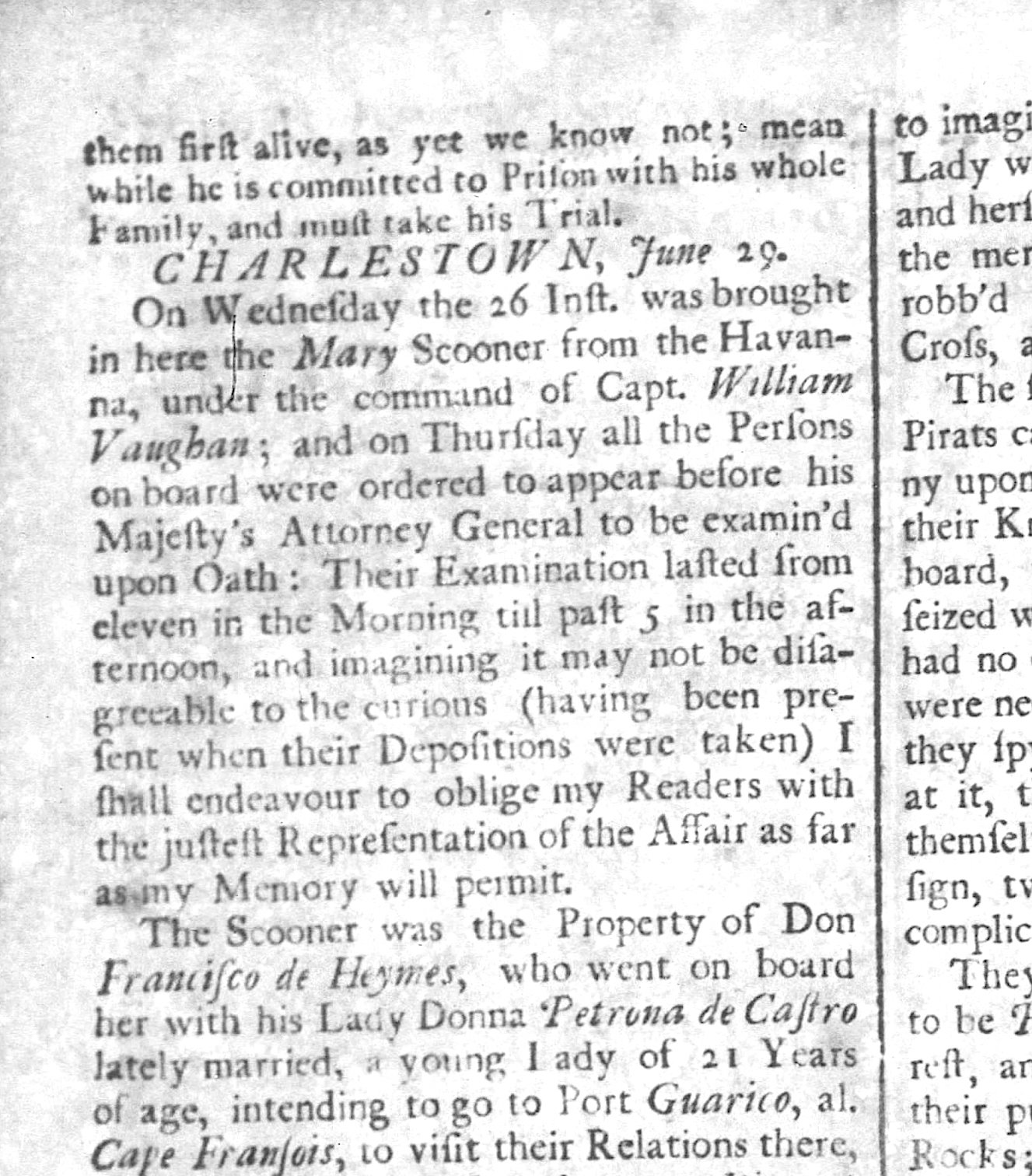
Later in the afternoon of Saturday the 29th, Peter Timothy informed the community through his weekly South Carolina Gazette that Attorney General Abercromby had deposed six survivors from a recently-arrived Cuban schooner called the Nuestra Señora, during a six-hour session attended personally by the printer. “Imagining it may not be disagreeable to the curious,” said Timothy’s Gazette, “I shall endeavour to oblige my readers with the justest representation of the affair as far as my memory will permit.” Timothy then recounted the schooner’s abominable journey from Havana to the Bahamas to Florida to Charleston with literary relish. “There are several strong suspicions and evidence against the carpenter, that he was of the pirates party,” reported Timothy; “his share of the money being found in his chest on search made: He is therefore committed to goal [sic; jail], to have a further trial.”
Having summarized the sordid history of Nuestra Señora, Timothy turned to the plight of the Cuban widow now ensconced in Charleston. “’Twill not be very difficult for any person to imagine the terrible condition the young lady was in,” he wrote, “seeing her husband murder’d, and herself surrounded with, and entirely at the mercy of [,] such execrable villains, who robb’d her of her ear-rings, a diamond cross, and several rings.” Thanks to the brave counter-mutiny staged off the coast of Florida, Timothy concluded, the two last pirates had “gain’d the ample reward of their treachery.”[7]
Under the vigilant gaze of Governor Robert Johnson during the sultry heat of July 1734, numerous agents of the colonial government and Charleston’s legal community gathered within the Council Chamber to investigate and try the Hispanic carpenter for his role in the murderous piracy aboard the Nuestra Señora. Tune in next week for the climax of Doña Petrona’s worst summer vacation ever, featuring courtroom drama, a joyful delivery, and the quiet departure of the cursed Cuban schooner.
[1] Jane Grassett (died August 1735) and her husband, Samuel Grassett, baptized several children at St. Philip’s Church, including Lidia (born 1724), Samuel (1725–1729), and Jane (born 1731); see A. S. Salley Jr., ed., Register of St. Philip’s Parish, Charles Town, South Carolina, 1720–1758 (Charleston, S.C.: Walker Evans & Cogswell, 1904), 61, 170, 109, 111, 113, 119, 234, 239, 246, 255. The mother of Henry Laurens (1724–1792), Esther Grassett Laurens (ca. 1700–1742), was likely the sister-in-law of this Jane Grassett.
[2] South Carolina Gazette, 22–29 June 1734, pages 2–3. Council Journal, folio 1, recto, mentions the presence of six written depositions, but does not include their respective texts.
[3] I plan to explore the 1725–28 construction history of the Council Chamber and Watch House (which superseded an earlier structed at the same location) in a future podcast.
[4] For a unique documentary record of the bilateral “Articles of Friendship” signed by Governor Johnson in the Council Chamber on 29 November 1733, see South Carolina Department of Archives and History, Journal of His Majesty’s Council, No. 5 part 2 (1733), pages 664–68, 672–73.
[5] Council Journal, folio 1, recto.
[6] Council Journal, folio 1, verso; folio 2, recto and recto.
[7] South Carolina Gazette, 22–29 June 1734, pages 2–3.
NEXT: Mutiny and Murder aboard Nuestra Señora de la Concepçion, Part 4
PREVIOUSLY: Mutiny and Murder aboard Nuestra Señora de la Concepçion, Part 2
See more from Charleston Time Machine
